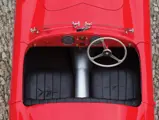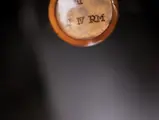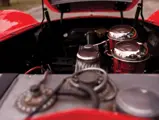Villa Erba 2013
1947 Cisitalia 202 SMM 'Nuvolari' Spyder by Carrozzeria Garella
{{lr.item.text}}
€425,600 EUR | Sold
 | Cernobbio, Italy
| Cernobbio, Italy
{{internetCurrentBid}}
{{internetTimeLeft}}

- Unique all-steel prototype for the 202 Spyder
- First raced by Cisitalia founder Piero Dusio
- 1947 Mille Miglia works team car
- Placed 4th overall at the 1947 Mille Miglia
60 hp, 1,089 cc OHV inline four-cylinder engine, dry sump with two valves per cylinder, two 36 mm Weber carburettors, four-speed manual gearbox, independent front suspension via lower wishbones and transverse leaf spring with telescopic dampers, live rear axle with semi-elliptic leaf springs and telescopic dampers, and four-wheel drum brakes. Wheelbase: 2,400 mm (94.5 in.)
Throughout the 1930s, Turinese texile industrialist Piero Dusio indulged his passion for motorsport. After winning his class on the 1937 Mille Miglia, he began to explore the possibilities of building his own racing cars. In 1946, the D46 single-seater appeared, built using readily-available Fiat mechanicals within a tubular steel space-frame chassis crafted at Cisitalia’s bicycle factory. The lightweight car swept all before it in the hands of Dusio and some of the greatest names of the day, such as Clemente Biondetti, Piero Taruffi, and Raymond Sommer.
Meanwhile, the D46 provided the foundations of Cisitalia’s first sports car, the 202, which was engineered by former Fiat aircraft designer Giovanni Savonuzzi. It was the racing variant, the 202 Spyder, which would write one of the greatest legends in motorsport at the 1947 Mille Miglia, when the maestro himself, Tazio Nuvolari, wrung a mighty performance from the little Cisitalia against the more powerful Alfa Romeo of Biondetti. Although suffering from the respiratory disease that would ultimately claim his life, the “Flying Mantuan” put in one of his most mesmerizing performances at the head of Cisitalia’s three-car works team.
Leading by eight minutes at the Modena checkpoint, only ignition problems caused by the torrential rain denied the maestro a historic victory. Nevertheless, he restarted and pressed on relentlessly to claim 2nd place overall and lead a 2-3-4 result (this particular example car placing 4th overall) for Cisitalia in the world’s most celebrated road race—with the 202 Spyder being dubbed ‘Nuvolari’ in his honour.
This actual car presented today, chassis 002S, was one of the three works entries for the 1947 edition of the Mille Miglia. It was first driven in competition by Dusio himself in May 1947, and it was the only steel prototype Spyder that had some different features, such as shorter doors and other detail work, which made it unique from its sister cars. One month later, Dusio entered chassis 002S into the 1947 Mille Miglia as one of its three works entries, and it was driven by Eugenio Minetti, with Piero Facetti alongside, to an incredible 4th place, in a time of 17 hours and 40 seconds for the 1,133 mile course.
The history file of 002S contains fabulous black-and-white period photos of Minetti and Facetti at the wheel of this works Cisitalia on the roads of the 1947 Mille Miglia. Given the impressive finish, it is no surprise that photos of his actual car can be found in many of the definitive Mille Miglia books.
After being retired from the works team, the car’s original racing engine, 010, was replaced with unit number 029, documented on the chassis plate, which it retains to this day. The car was sold to an unknown owner in the U.S.A., appearing in the 1951 edition of Sports Cars Illustrated, and it was subsequently owned by a number of American collectors until 1999, when it was purchased by the current owner and returned to Europe.
A comprehensive initial restoration was carried out by Bruno Kunis in Zurich, and then this car was taken back to Brescia, where it was a welcome entrant in the Mille Miglia Retrospectives of 2001, 2002, and 2004. As the current owner explains, “There is nothing like taking a car that has come 4th overall on the Mille Migla back to the event; it makes it an even more special experience given the historical importance of this particular car in relation to the event”.
After the successful participations at the Mille Miglia Retrospectives, and prior to the sale, chassis 002S was brought back to bare metal, where the body was checked, and any points of corrosion were repaired before the car was given a bare metal respray in Switzerland. Photos of the work carried out are available on file. Once the body work was complete, the current owner commissioned a full mechanical check to ensure the car is ready to be used on the next Mille Miglia Retrospective. Chassis 002S has recently and successfully passed the Swiss controle technique, and so, it is offered for sale with current Swiss registration, as well as documentation on the recent work that has been carried out.
This is one of the most evocative sports racing cars of the immediate post-war period, and it is a car that will always be guaranteed an entry into the one of the most charismatic retrospectives in the world, La Mille Miglia.

























